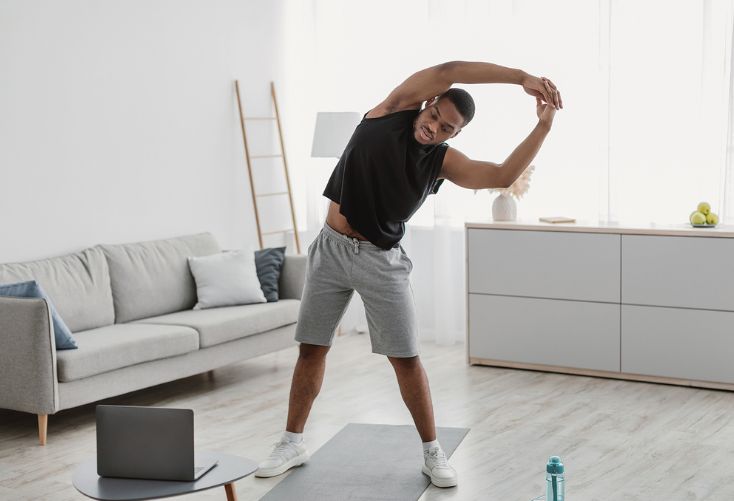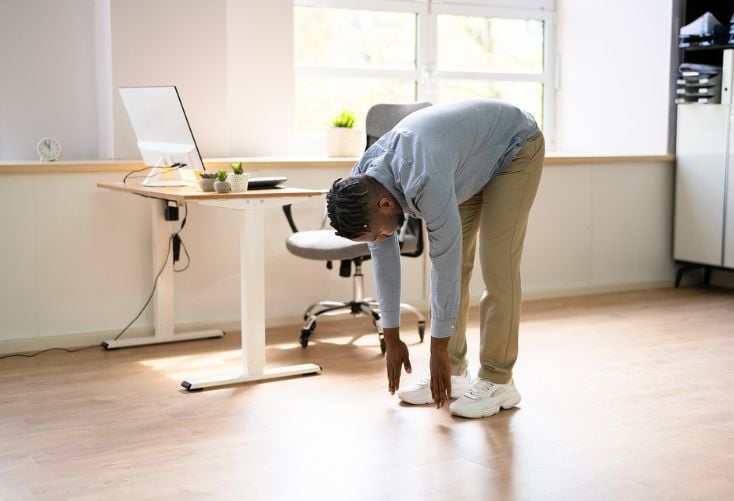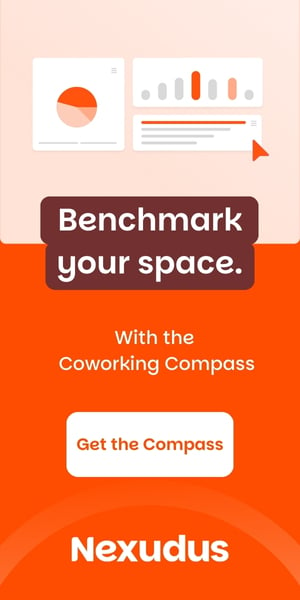- Stretching is essential for health and wellness because it can improve posture, lessen pain, and help resolve physical issues.
- Standing desks are an alternative for workers not keen on sitting all day, but standing still for too long comes with its own set of aches and pains.
- Some of the best stretches that you can do at your desk to help alleviate pains include side bends, toe touches, the triangle pose, and the desk lat stretch, among others.
Everyone who has worked a desk job knows that sitting at a desk all day — especially if the set-up isn’t ergonomically sound — can be downright painful. Shoulder pain, a stiff neck and back and other discomforts are not uncommon for many workers.
While standing desks are a great alternative that can help posture and engage different muscles, they are not a cure-all for office-work-related pain. Where sitting all day causes lower back pain, standing all day can lead to upper back pain, lower extremity pain, and stiffness.
The physiological difference between sitting all day and standing all day is that sitting all day results in a slumped posture that causes the hip flexor muscles to contract, leading to a loss of blood flow to the lower back, and standing all day leads to fluid buildup in the leg veins, causing swelling and stiffness.
The good news is that stretching throughout the day is a great way to curtail some of the stiffness and pain that might come from working at a desk, regardless of how it’s configured. Stretching improves strength, reduces pain, and increases overall well-being.
Here are some of the best stretches you can do to improve flexibility while reducing swelling and pain caused by too much standing or sitting.
Note: These are all in-office friendly (depending on office attire). If anyone looks at you strangely, encourage them to try it and they’ll quickly understand why you’re stretching it out mid-day.
The Side Bend (Targets: upper back and hips)
The more you do side bends, the further into them you will get. Don’t worry if, at first, you aren’t making a “C” shape with your body. That’s normal. Each time you practice them, by a small increment, try to stretch a little deeper.
Instructions
- Stand straight with your feet together and shoulders back.
- Hold both hands above your head, interlocked with the index finger stretched to the sky.
- Stretch your arms up in the air as high as possible — try to touch the ceiling with your index finger without tippy-toeing.
- Bend at the hip slowly to the right, pushing the left hip out as far as you can.
- Squeeze the glute muscles to keep your hips in a straight line.
- Repeat on the left side.
Do two sets of 60 seconds per side.
 Toe Touches (Targets: hamstrings and glutes)
Toe Touches (Targets: hamstrings and glutes)
It’s ok if you cannot touch your toes at first. More than half of Americans can’t touch their toes, so it is nothing to be ashamed of.
Like side bends, try to go a little deeper each time you attempt a toe touch. Eventually, if you do that enough times, you may be able to grab your heels.
Instructions
- Stand straight with your feet together.
- Bend at the hip slowly until you reach as low to the floor as you can.
- Do two sets of 90 seconds.
 The Triangle Pose (Targets: hips and back)
The Triangle Pose (Targets: hips and back)
The triangle pose is a masterclass stretch accessible and valuable to all levels of flexibility, but is likely the hardest on this list.
Don’t worry about going too low if you are stiff, but thank yourself afterward because the triangle pose stretches the entirety of your legs, back, and hips. In addition, it is the “most bang for your buck” stretching pose for people with standing-related aches and pains.
Instructions
- Stand straight with your shoulders back.
- Take a comprehensive step to your right.
- Keep your left foot in the same position, but shift the position of your left foot to align with your knee.
- Spread your arms out at the wingspan.
- Squeeze the glutes to maintain core stability and posture.
- Bend the right knee and go as low down as you can.
- Move both arms simultaneously, so your right hand is touching your right big toe, your right elbow is touching your right knee, and your left arm stretches straight up to the ceiling.
- Hold this position for 30 seconds.
- Repeat on the left side.
Do two sets.
 The Desk Lat Stretch (Targets: shoulders and upper back)
The Desk Lat Stretch (Targets: shoulders and upper back)
The desk lat stretch is great because, for one thing, it allows you to use a standing desk as an exercise tool, and it is also excellent for loosening up your shoulders and upper back.
Instructions
- Make sure your standing desk is sturdy and will not move without strenuous effort.
- Stand with your feet shoulder-width apart.
- Place your hands on the edge of your standing desk.
- With your hands still in place, stand back until your arms are straight and perpendicular to the floor.
- Bend over at the hips forward.
- Pull with moderate strength on the desk.
- Push your hips back at your lower back while pulling with your arms.



 Dr. Gleb Tsipursky – The Office Whisperer
Dr. Gleb Tsipursky – The Office Whisperer Nirit Cohen – WorkFutures
Nirit Cohen – WorkFutures Angela Howard – Culture Expert
Angela Howard – Culture Expert Drew Jones – Design & Innovation
Drew Jones – Design & Innovation Jonathan Price – CRE & Flex Expert
Jonathan Price – CRE & Flex Expert











